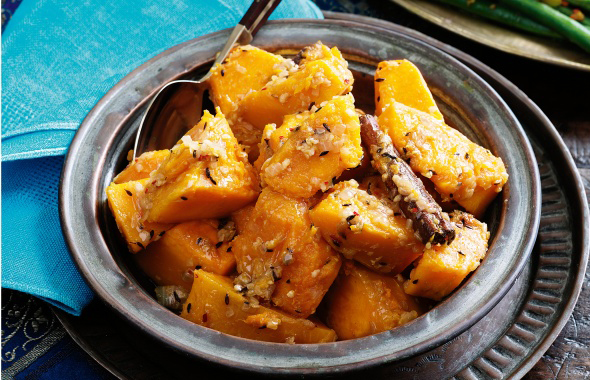Mama’s Punjabi Recipes – Pethe Di Sabzi (Sauteed Pumpkin)
Although the biggest use of petha (pumpkin) in India is to make the white, crystallized delicacy made famous in Agra, in North India we also make not only the sweet petha da halwa but a regular, salted, spicy dish that all love to eat with roti and paranthas. In the US, during the Halloween season when pumpkins are so widely available, it is a good opportunity to make a dish other than the traditional pumpkin pie.
In North India, the yellow-orange petha of the plains is also known as kanshi phal, kashi or Sita phal in Hindi and it is often made during the harvest season in many homes as an change to the usual mix of vegetables which are eaten throughout the year. This dish is usually prepared without onions as petha is considered a pure and holy vegetable that can be eaten by people who are fasting. In the preparation of the dish it is important to dry up most of the water that is released during the cooking process.
The byproduct of cooking with petha are the large white seeds that can be collected, washed and dried in the sun to eat later, either roasted or raw. One can also collect watermelon seeds or cantaloupe seeds and do the same and save the cost of buying these at high prices from the stores. But now, even in India, people will buy them from stores rather than do it themselves at home as my mother used to do.
Ingredients:
1 kg petha (pumpkin)
1 tsp methi dana (fenugreek seed)
2 tbsp olive oil or makhan (butter)
Spices: lal mirch (red pepper); namak (salt); haldi (turmeric) – to your taste
Directions:
1. Peel the petha, chop into small pieces, wash them in a strainer and let them drip dry.
2. Heat the oil in a saucepan, add the methi dana and spices then add the chopped petha. Stir well to coat and turn the heat down to medium. Cover and let the petha cook in its own steam till it is soft.
3. Check to see if it is soft. Let it cook for 5 more minutes, then mash well with a large spoon or spatula and keep stirring till the water evaporates, making sure that it does not stick to the bottom.
4. When all the water is gone, the oil will come towards the edges of the saucepan and then turn the heat off. Let it cool down before eating. This dish is not usually prepared with many spices.
Shakuntla Malhotra is a skilled cook of Punjabi dishes made in the old-fashioned style that she learnt as a young woman in her ancestral home in Lyallpur, India before it became part of Pakistan after the Partition in 1947. People have often admired her cooking for its simplicity and taste that comes with each mouthful. Even in her mid-eighties, she continues to cook daily and agreed to share some of her delectable Punjabi recipes.
MAMA’S TIP OF THE WEEK
KEEP BANANAS FRESH AND YELLOW IN THE FRIDGE
Everyone loves bananas in this country where they are available all year long, especially the long, plump Cavendish variety which are a common sight in most grocery stores. Bananas are a very high in potassium and a quick source of glucose for those whose blood sugar levels have fallen too low. Most people buy a bunch of bananas and leave them in a basket or hang them on a hook outside, often for looks, and then see them become dark and bruised in a few days.
We should take a tip from the way the grocery stores keep the bananas fresh looking even after they are shipped in by truck. They keep them in a plastic bag and in the cooler and this will work at home too. When you bring the bananas home, place them in a clear plastic back, close the top and put them in the refrigerator. The bananas will stay yellow and unbruised much longer: at most they may become darker.


